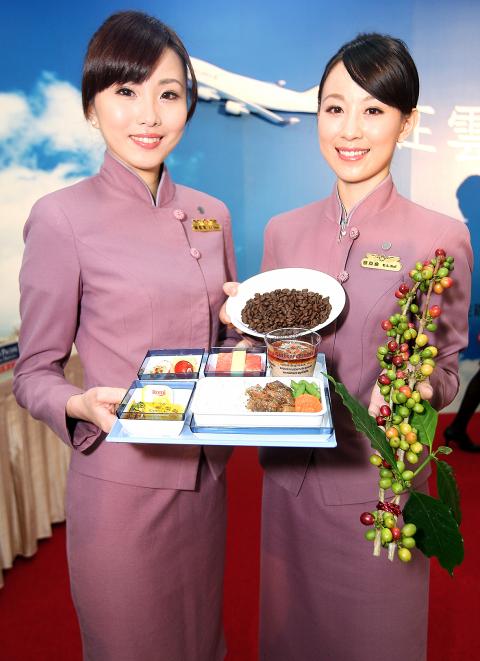Starting on Monday, passengers on China Airlines’ (CAL) flights to Japan and South Korea will be able to taste Dongshan coffee (東山咖啡) flavored-chicken.
The dish using coffee beans from Greater Tainan was jointly developed by CAL’s China Pacific Catering Services, the Tourism Bureau, the Greater Tainan Government’s Agricultural Bureau and the Dongshan Coffee Association.
Greater Tainan Mayor William Lai (賴清德) described the debut of the coffee chicken as “historic,” with the Dongshan coffee being marketed in new countries through the CAL flights.

Photo: CNA
According to CAL, the coffee chicken is flavored with filtered Dongshan coffee. The tannic acid in the coffee tenderizes the chicken, making the meat tender and tasty with a light coffee aroma.
The idea for coffee chicken was proposed by China Pacific Catering Services chairwoman Janice Lai (賴瑟珍), formerly Tourism Bureau director-general. She said that award-winning Taiwanese chef Shih Chien-fa (施建發) had mentioned that he had seen coffee used to flavor dishes in restaurants in Singapore. That inspired her to try to make coffee-flavored dishes in Taiwan.
“Many foreigners know that Taiwan is known for its tea, but few know Taiwan also produces high-quality coffee,” Lai said.
She said tourists could learn about Taiwan by enjoying in-flight meals featuring Taiwanese ingredients, adding that they would then want to know the origin of the ingredients after the flight.
The airline said the coffee chicken was merely a first step in using coffee in other dishes. It is considering serving coffee-flavored pork chops, tenderloin, sausages and chicken broth.
Tourism Bureau deputy director general Wayne Liu (劉喜臨) said the nation’s 12 scenic area administrations have begun calling Lai following the creation of the coffee chicken and recommending other ingredients for the airline’s onboard meals, including bell fruit and dried mullet roe.
The airline could include one new dish featuring ingredients from a different scenic area each month, Liu said.
The coffee chicken will be served to passengers on flights to Fukuoka, Hiroshima, Miyazaki, Sapporo, Nagoya, Shizuoka and Takamatsu in Japan, as well as to Seoul and Gimpo in South Korea, CAL said.

US climber Alex Honnold is to attempt to scale Taipei 101 without a rope and harness in a live Netflix special on Jan. 24, the streaming platform announced on Wednesday. Accounting for the time difference, the two-hour broadcast of Honnold’s climb, called Skyscraper Live, is to air on Jan. 23 in the US, Netflix said in a statement. Honnold, 40, was the first person ever to free solo climb the 900m El Capitan rock formation in Yosemite National Park — a feat that was recorded and later made into the 2018 documentary film Free Solo. Netflix previewed Skyscraper Live in October, after videos

Starting on Jan. 1, YouBike riders must have insurance to use the service, and a six-month trial of NT$5 coupons under certain conditions would be implemented to balance bike shortages, a joint statement from transportation departments across Taipei, New Taipei City and Taoyuan announced yesterday. The rental bike system operator said that coupons would be offered to riders to rent bikes from full stations, for riders who take out an electric-assisted bike from a full station, and for riders who return a bike to an empty station. All riders with YouBike accounts are automatically eligible for the program, and each membership account

NUMBERS IMBALANCE: More than 4 million Taiwanese have visited China this year, while only about half a million Chinese have visited here Beijing has yet to respond to Taiwan’s requests for negotiation over matters related to the recovery of cross-strait tourism, the Tourism Administration said yesterday. Taiwan’s tourism authority issued the statement after Chinese-language daily the China Times reported yesterday that the government’s policy of banning group tours to China does not stop Taiwanese from visiting the country. As of October, more than 4.2 million had traveled to China this year, exceeding last year. Beijing estimated the number of Taiwanese tourists in China could reach 4.5 million this year. By contrast, only 500,000 Chinese tourists are expected in Taiwan, the report said. The report

Temperatures are forecast to drop steadily as a continental cold air mass moves across Taiwan, with some areas also likely to see heavy rainfall, the Central Weather Administration (CWA) said. From today through early tomorrow, a cold air mass would keep temperatures low across central and northern Taiwan, and the eastern half of Taiwan proper, with isolated brief showers forecast along Keelung’s north coast, Taipei and New Taipei City’s mountainous areas and eastern Taiwan, it said. Lows of 11°C to 15°C are forecast in central and northern Taiwan, Yilan County, and the outlying Kinmen and Lienchiang (Matsu) counties, and 14°C to 17°C